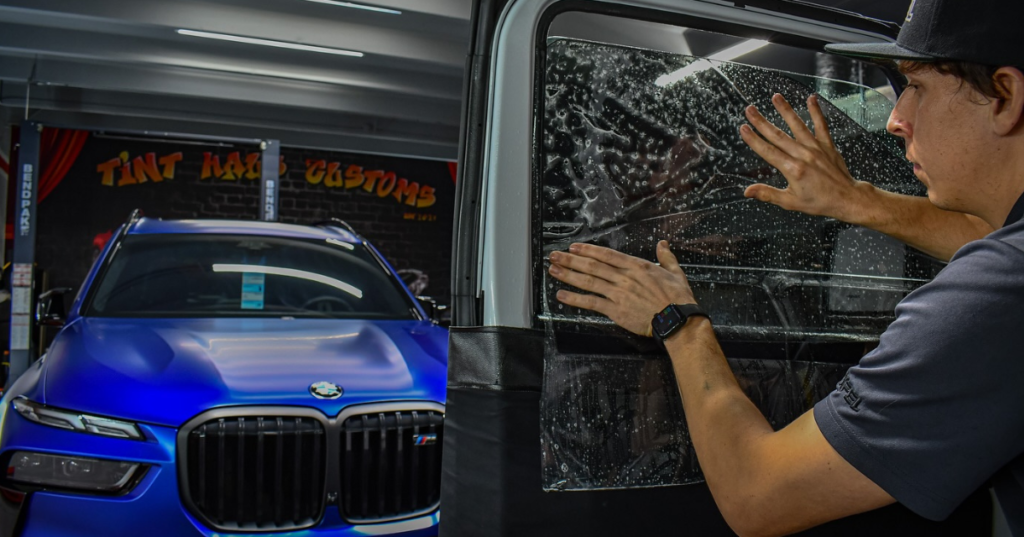When it comes to window tinting, timing really can make or break your investment. You might think any day’s a good day to install tint, but overlooking seasonal conditions could lead to costly mistakes like bubbling or peeling. If you’re considering a tint job, window tinting in South Florida requires special attention due to the region’s heat and humidity, which can impact the curing process. It’s crucial to understand why certain times of the year are far better than others. By choosing wisely, you not only enhance the look of your windows but also guarantee they last longer. Curious about the specific conditions to avoid and the best practices to follow?
Choosing the Wrong Season
When you’re considering window tinting service, timing can make all the difference. Choosing the right season is essential to guaranteeing the longevity and effectiveness of your tint. Seasonal considerations play a significant role in how well the tint adheres to your windows and how it performs over time.
For instance, installing window tint during the winter months might seem appealing due to fewer UV rays, but cold temperatures can affect the adhesive’s performance, leading to uneven application or peeling.
On the other hand, summer brings its own challenges. If you live in a region with extreme heat, the intense sun can actually cause the adhesive to dry too quickly, resulting in bubbles and imperfections. The climate impact also varies based on your location; areas with high humidity might experience different adhesion issues compared to drier climates.
By understanding these seasonal nuances, you can better plan your window tinting project. Ideally, aim for a mild season—like early spring or fall—when temperatures are moderate. This not only guarantees a smoother installation but also enhances the durability of the tint.
Ultimately, timing your window tinting right can save you from costly mistakes and help you enjoy the benefits of your investment. You’ll not only feel a greater sense of belonging in your perfectly tinted space, but you’ll also protect your vehicle’s interior from harmful UV rays and excessive heat.
Choose wisely, and your windows will thank you.
Ignoring Temperature Conditions
While it may be tempting to overlook temperature conditions during window tint installation, doing so can lead to significant problems. Understanding the impact of temperature extremes and humidity levels is essential for guaranteeing your tint adheres properly and lasts as intended.
When temperatures soar or plummet, the adhesive properties of the tint can be compromised. For instance, applying tint in sweltering heat can cause the film to stretch and bubble, while frigid conditions might prevent the adhesive from bonding effectively. To achieve the best results, it’s important to monitor both the ambient temperature and the surface temperature of your windows before installation.
Humidity levels also play a significant role in the installation process. High humidity can introduce moisture between the film and the glass, leading to peeling or fogging. Conversely, extremely low humidity can result in static electricity, causing dust particles to cling to the adhesive surface, which can ruin the aesthetic appeal of your tint.
To guarantee a successful installation, aim for a temperature range between 40°F and 100°F, with humidity levels ideally kept between 30% and 70%. By being mindful of these conditions, you’re not just enhancing the appearance of your vehicle; you’re also investing in the longevity of your window tint.
In the end, a little attention to temperature and humidity can save you from costly repairs and the frustration of a tint job gone wrong.

Skipping Professional Installation
Although you might think that installing window tint on your own is a cost-effective option, skipping professional installation can lead to a host of headaches and poor results.
When you opt for DIY, you miss out on the professional benefits that come from hiring an expert. Professional installers possess the installation expertise necessary to guarantee a flawless application, which is vital for aesthetics and functionality.
Without experience, you might struggle with alignment, resulting in bubbles or creases that detract from your vehicle’s appearance. Additionally, improper installation can cause the tint to peel or fade prematurely, negating any savings you hoped to achieve. A professional understands how to handle different types of films and can recommend the best options for your specific needs.
Moreover, professionals are well-versed in local regulations regarding window tinting. They’ll help you comply with laws, preventing potential fines and the hassle of having to remove incorrectly applied film later on. This level of knowledge can save you time and frustration.
Neglecting Manufacturer Instructions
Neglecting manufacturer instructions can lead to significant issues during the window tinting process. When you skip over the manufacturer guidelines, you might be setting yourself up for installation errors that could compromise the tint’s effectiveness and longevity.
Each window tint product comes with specific instructions tailored to the materials and tools needed for a successful application. If you don’t follow these guidelines, you risk improper adhesion, which can cause peeling or bubbling over time.
Additionally, deviations from recommended techniques can result in a subpar appearance, diminishing the aesthetic value you aimed for. It’s essential to pay attention to details such as the correct temperature ranges for installation and recommended cleaning methods for surfaces prior to applying the tint.
Ignoring these instructions can also void any warranty offered by the manufacturer. If you encounter problems down the line, you may find that the manufacturer isn’t willing to assist you because you didn’t adhere to their recommendations.
Ultimately, sticking to the manufacturer guidelines isn’t just about following rules; it’s about guaranteeing that you’re part of a community that values quality and professionalism in window tinting.
Overlooking Cure Times
When you rush the window tinting process by overlooking cure times, you risk undermining the quality of your installation. Cure time is important because it allows the adhesive to bond properly to the glass, ensuring that your tint performs as intended. Skipping or shortening this essential step can lead to bubbling, peeling, or even complete failure of the tint.
Understanding cure time importance means recognizing that different films and adhesives require specific durations to dry completely. This period can vary based on environmental factors like temperature and humidity. For instance, if it’s too humid, the drying process may take longer than expected.
Patience is key here—allowing the film to cure fully helps maintain its integrity and appearance.
During the initial drying phase, avoid rolling down your windows or cleaning the tint. This is where proper drying becomes critical; any disturbance can compromise the installation. It’s best to follow the recommendations provided by your installer or the film manufacturer.
Selecting Low-Quality Film
Selecting low-quality film can lead to a host of problems that undermine both the aesthetic and functional benefits of window tinting. When you choose inferior materials, you’re not just risking your investment; you’re also compromising the overall tint performance and film durability.
Low-quality films often fade, bubble, or peel over time, leaving your windows looking worse than before.
Here are a few key issues you might encounter with subpar window tint:
- Inconsistent Color: Low-quality film can discolor unevenly, ruining the sleek look you desire.
- Poor UV Protection: Many cheap films don’t effectively block harmful UV rays, putting your skin and interior at risk.
- Short Lifespan: With low durability, these films require frequent replacements, costing you more in the long run.
When selecting window tint, prioritize quality over cost. High-quality films not only enhance the aesthetics of your vehicle, but they also provide superior protection against UV rays and heat.
Investing in reputable brands guarantees that your tint will maintain its appearance and functionality for years to come.
Failing to Clean Windows Properly
Properly cleaning your windows before applying tint is essential, as any residue left behind can lead to a host of issues. If you skip this vital step, you might find that the tint adheres poorly, resulting in bubbles, peeling, or even discoloration over time. For those who want their tint to look flawless and last, investing time in window preparation is non-negotiable.
Start by gathering the right cleaning supplies. Use a soft cloth or microfiber towel, a high-quality glass cleaner, and, if necessary, a scraper for stubborn spots. Avoid using ammonia-based cleaners, as they can harm the tint film. Instead, opt for gentle cleaning techniques that effectively remove dirt, grease, and any previous window treatments without causing damage.
Begin the cleaning process by thoroughly wiping the glass to eliminate any dust or debris. Pay special attention to the edges where grime tends to accumulate. If you encounter any tough spots, gently use a scraper to lift them away, ensuring you don’t scratch the glass.
Once the surface is spotless, rinse it with clean water and dry it completely, leaving no streaks or moisture behind.
Installing Tint on Damaged Glass
Installing window tint on damaged glass can lead to a range of complications that detract from both the appearance and effectiveness of the tint. When you attempt to apply tint over glass that’s chipped, cracked, or otherwise compromised, you’re setting yourself up for issues that can undermine your investment.
Here’s what you should consider:
- Poor Tint Adhesion: Damaged glass creates uneven surfaces, which can prevent the tint from adhering properly. This can result in bubbles or peeling over time.
- Aesthetic Concerns: Cracks or chips will be highlighted once the tint is applied, leading to an unappealing look that’s difficult to fix.
- Reduced Longevity: If the glass is already compromised, applying tint may accelerate the deterioration of both the glass and the film, reducing its lifespan.
To achieve ideal results, it’s essential to address any issues with the glass before proceeding with tint installation.
Repairing or replacing damaged glass not only enhances the overall appearance but also guarantees better tint adhesion. A well-maintained surface allows the film to adhere effectively, providing you with the desired benefits, such as UV protection and enhanced privacy.
Ultimately, it’s worth taking the time to verify that your glass is in good condition before applying tint. You’ll save yourself from future headaches and enjoy the full benefits that quality window tint has to offer.
Rushing the Installation Process
Although it might be tempting to rush the installation process to save time, doing so can lead to significant problems that compromise the quality and effectiveness of your window tint. Proper window tinting requires meticulous attention to detail, and cutting corners can result in bubbles, peeling, or improper adhesion.
To achieve a flawless finish, you must adhere to established installation techniques. Each step, from cleaning the glass thoroughly to applying the film with precision, is critical. If you skip or hastily perform any of these preparation steps, you risk not only the appearance of your tint but also its longevity. Dust, dirt, or moisture trapped under the film can cause permanent damage, leading to costly reapplications.
Taking the time to prepare the surface adequately guarantees that you’re setting the stage for a successful installation. This includes checking for imperfections in the glass and confirming it’s free from contaminants. Rushing through these elements may seem like a shortcut, but it’s likely to backfire, leaving you frustrated with subpar results.
Moreover, consider the curing time recommended by the manufacturer. If you don’t allow your tint to set properly, it may not adhere as intended, resulting in premature failure.
To Sum Up
So, if you want your window tint to last longer than a Hollywood blockbuster, timing is everything! By avoiding these common mistakes—like installing in extreme weather or skipping the pros—you’ll save yourself from a bubbling disaster that could rival a sci-fi movie. Tint Haus Customs knows that it’s not just about a sleek look; it’s about ensuring your investment shines for years to come. Don’t let poor choices turn your windows into a tinting tragedy; plan wisely and enjoy the benefits!
